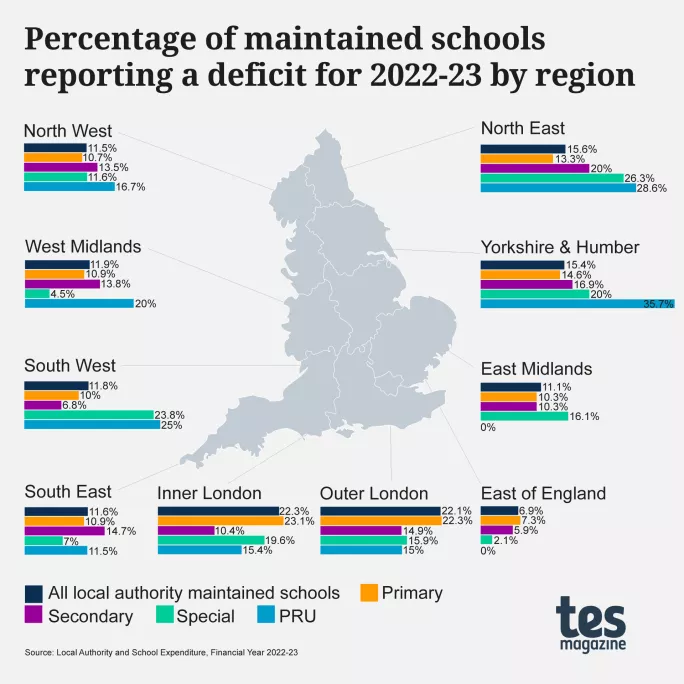Revealed: The schools worst hit by the costs crisis

Nearly a quarter of maintained primary schools in London were in deficit last year, government data has revealed.
In inner London, 23.1 per cent of primaries reported a deficit for the financial year 2022-23, according to figures from the Department for Education (DfE).

A similar proportion (22.3 per cent) of outer London primary schools reported a deficit for 2022-23.
Havering had the highest number of primaries in deficit, with 44.7 per cent. A total of 21 local authorities had more than a quarter of their maintained primary schools in debt, according to the data.
This comes as London boroughs are expected to see an average fall of 7.3 per cent in pupils starting Reception in the next five years.
- More on local authority spending: DfE in bid to sign 5 new SEND bailout deals
- Funding: Schools ‘face new financial crisis’ as costs remain high
- Related: Barran urges ‘caution’ over school closures amid falling rolls
The overall number of maintained schools in the red was 13 per cent, four percentage points higher than in 2021-22.
The percentage of schools in deficit increased across all types of school. A large proportion of pupil referral units (17.2 per cent) reported a deficit nationally, but the numbers in the red were more pronounced in the North of England, with more than a third (35.7) of PRUs in Yorkshire and the Humber and more than a quarter in the North East (28.6 per cent) reporting deficits last year.
For primary schools, the percentage reporting deficits overall grew from 7.6 per cent in 2021-22 to 12.3 per cent.
Speaking last year, DfE minister Baroness Barran admitted that the financial health of schools was a “more negative picture” among maintained schools.
She also acknowledged that primary schools often have a tighter financial model than secondaries, particularly smaller primaries.
The impact on school funding from falling rolls could lead to schools, particularly primaries, needing to close, restructure or amalgamate, the government has been warned.
Spending increase on supply teachers
Spending in general has grown in local authority maintained schools, the data shows. But spending in specific areas jumped exponentially as schools reacted to rising costs and demand.
Maintained schools spent £486 million on agency supply teachers in 2022-23, a 17 per cent increase on the year before, in a bid to cope with an escalating teacher recruitment shortage.
In pupil referral units, spending on supply teachers per pupil was the highest, at £1,411, compared with £155 in secondary schools.
However, the largest spending increase for maintained schools in 2022-23 was energy costs as bills soared due to international pressure on supply.
These increased by 60.8 per cent, from £301.8 million in 2021-22 to £485.3 million last year.
Tes revealed that some schools were seeing bills increase by tens of thousands of pounds in 2022.
Spiralling SEND costs
The data also shows that spending on special educational needs and disabilities (SEND) support services jumped by 8.8 per cent to £537.7 million in 2022-23.
Spending on therapies and health-related services, such as speech, physiotherapy and special medical support, increased by more than a quarter (26.7 per cent) to £78.3 million.
Local authorities also saw spending on transport for pupils with SEND increase by 24.4 per cent to £1.3 billion.
The DfE has ongoing programmes to help local authorities deal with growing high-needs deficits, including the controversial Safety Valve programme.
There are already 34 local authorities with Safety Valve agreements to reform their SEND services in place, and five more are in talks to join the programme.
A DfE spokesperson said: “While the vast majority of schools are operating with a surplus, we are providing up to £40m in 2023-24 to support schools which find themselves in financial difficulties.”
For the latest education news and analysis delivered directly to your inbox every weekday morning, sign up to the Tes Daily newsletter
You need a Tes subscription to read this article
Subscribe now to read this article and get other subscriber-only content:
- Unlimited access to all Tes magazine content
- Exclusive subscriber-only stories
- Award-winning email newsletters
Already a subscriber? Log in
You need a subscription to read this article
Subscribe now to read this article and get other subscriber-only content, including:
- Unlimited access to all Tes magazine content
- Exclusive subscriber-only stories
- Award-winning email newsletters
topics in this article



